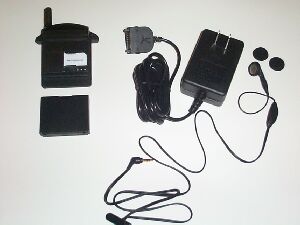Handspring Visor users want it all. They want as many features
as possible crammed into their Springboard modules. More and more,
we're seeing Springboard modules that have more than one function.
With the Handspring VisorPhone, one can 1) dial numbers directly from their
address book, 2) use it as a GSM cellular phone, 3) send messages to others
using SMS, and 4) dial into an ISP and browse the Internet. What
more could you want?
Hardware
 The
VisorPhone uses the GSM Standard for the
U.S. and operates at 1900 MHz. The back of the module detaches so
you can insert your SIM card that your service carrier provides you with.
One of the major benefits of GSM is that you can take a SIM card (or smart
card) from one phone, plug it into another GSM-capable phone, and use it
right away.
The
VisorPhone uses the GSM Standard for the
U.S. and operates at 1900 MHz. The back of the module detaches so
you can insert your SIM card that your service carrier provides you with.
One of the major benefits of GSM is that you can take a SIM card (or smart
card) from one phone, plug it into another GSM-capable phone, and use it
right away.
A speaker lets you hold the Visor to your ear and use the VisorPhone
like any normal phone; by plugging the included headset into the headphone
jack on the left side of the module you can access all of your Visor's
applications while still using the VisorPhone. There is also a silent
alarm that you can set to vibrate instead of using one of the 12 audio
alarms available.
The VisorPhone has quick-access buttons for its SMS and Phone applications,
a slider to switch between loud and soft rings, and an power button.
An LED indicates the VisorPhone's status:
No light = Phone off
Solid red = Battery charging
Solid green = Fully charged
Slow red blink = No service
Slow green blink = In service
Fast red blink = Low Battery
Fast green blink = Data call
activeThe VisorPhone uses a rechargeable Lithium Ion battery pack that
provides up to 3 hours of talk time or 3 days of standby time. An
included A/C adapter connects to the serial port of your Visor to recharge
the VisorPhone's battery. This adapter will recharge a Visor
Prism as well. The VisorPhone will also recharge when in the Visor
Prism's cable, and you can still receive phone calls.
Making a Call >>